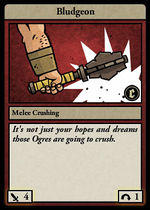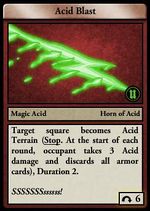Combat
Combat in Card Hunter is largely straightforward a la traditional dnd. A combat sequence generally consists of an attack from an instigator, a block roll and/or an armor roll from the target. There are multiple attack types and damage types, as well as multiple types of blocks and armors. This guide presents some basics with regard to combat and commonly encountered keywords associated with attack, block and armor cards. Readers are advised to browse the Card Types and Keywords basic guide for detailed information.
Attack
An attack comprises of a damage payload and a delivery mechanism. The damage payload is described by two components: a damage type and a magnitude. The delivery mechanism refers to the way in which the payload is transferred, described by an attack type and a range. In Card Hunter, an attack does not necessarily need to have an attack range. A global attack that targets all units in the board has no attack range. In summary, an attack consists of four components:
- Attack range (optional)
- Attack type
- Damage type
- Damage value
|
Figure 1 shows a staple card: Bludgeon. Bludgeon is a fairly common attack card found in most weapons. It is of melee attack type with a range of 1. Unmitigated, Bludgeon deals 4 crushing damage. The attack type and damage type of a card is found in the card's information bar. The damage value is found beside the lower left sword symbol icon. The attack range is represented by a number beside the circular arrow symbol found in the lower right. Bludgeon is a very straightforward attack. It has no special keywords associated with it and does not carry other complicated instructions. |
Block
Coming Soon
Armor
Coming Soon

